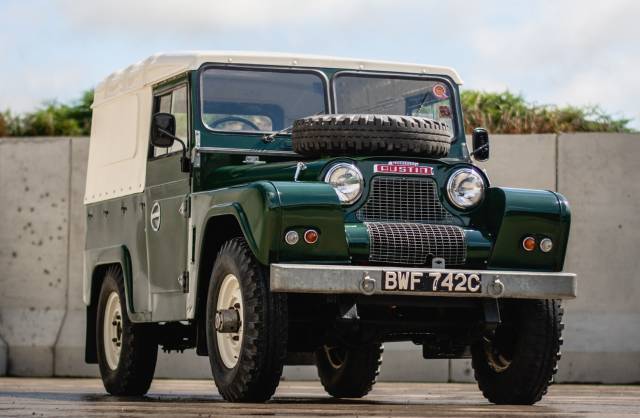Austin Gipsy classic cars for sale
The Austin Gipsy is a robust British off-roader manufactured from 1958 to 1968. Designed to rival the Land Rover, it features a steel body and was available with petrol and diesel engines. The Gipsy stands out for its unique suspension evolution and its rarity today makes it a fascinating find for collectors and enthusiasts.
Search results

1968 | Austin Gipsy
Austin Gipsy "Trade-in-car" PRICE REDUCTION! In a running condition but standing still for a longer period of time, Extraordinary but special object/project, Developed to compete against the original series Land Rovers, The civilian replacement for the military Austin Cham, Stand out from the crowd with this “ATV”, used as a snowplow and salt-spreader by Berkshire County-UK in its early history

Austin Gipsy listing references from Classic Trader
Below you will find listings related to your search that are no longer available on Classic Trader. Use this information to gain insight into availability, value trends, and current pricing for a "Austin Gipsy" to make a more informed purchasing decision.

1968 | Austin Gipsy
Austin Gipsy "Trade-in-car" In a running condition but standing still for a longer period of time, Extraordinary but special object/project, Developed to compete against the original series Land Rovers, The civilian replacement for the military Austin Cham, Stand out from the crowd with this “ATV”, used as a snowplow and salt-spreader by Berkshire County-UK in its early history

1965 | Austin Gipsy
Zu finden auf der Classic Expo Salzburg 2021, Halle 6

1964 | Austin Gipsy
G4 M10 - Beautiful Condition Throughout
History of the Austin Gipsy
The Austin Gipsy was conceived in the late 1950s as an affordable yet capable successor to the Austin Champ. Its development aimed squarely at competing with the Rover Land Rover in both civilian and military markets. Early versions came with the innovative 'Flexitor' independent suspension, but a later move to live axles and leaf springs dramatically improved off-road abilities. The Gipsy was built with a steel body—unusual in its segment, as the Land Rover favoured aluminium, giving the Gipsy a distinctive edge but also influencing long-term durability. After Austin became part of British Leyland, the Gipsy's fate was sealed, as company strategy favoured the Land Rover. Production ended in 1968 after just over 21,000 units, making surviving examples increasingly rare.
Model History and Development
The Austin Gipsy took over where the Austin Champ left off, introducing utility with cost effectiveness. It was initially offered with a 2,286 mm wheelbase and later joined by a long wheel base (2,819 mm), denoted SWB and LWB, catering to a range of applications. Engine options included a 2.2-litre petrol engine—capable of running on low-octane fuel—and a 2.2-litre diesel. Production saw improvements in body and suspension, with later models featuring a split front grille and more conventional live axles. The range did not spawn notable successors, as British Leyland chose to consolidate production under the Land Rover badge.
Highlights and Unique Features
A defining trait of the Austin Gipsy is its steel construction, contrasting with its main competitor’s aluminium approach. The robust body could be ordered in various configurations, suited for both civilian and export markets. The early “Flexitor” rubber suspension was unique in the segment but was soon replaced by conventional leaf springs, giving later Gipsys superior off-road prowess. Hydraulic clutch and brake systems were also distinguishing technical features.
Technical Data
Special Editions and Collectible Models
While the Austin Gipsy did not officially have special editions in the sense of limited factory runs, vehicles produced for export or with specific military equipment do stand out among collectors. Some late-production models are distinguishable by their dual-section grille and changed suspension setup.
Weak Spots and Common Issues
Common maintenance points for the Austin Gipsy relate to its hydraulic systems: after prolonged storage, clutch and brake hydraulics often require attention. Steel bodywork is robust but susceptible to corrosion, particularly if previous restorations involved unusually thick paint. Restoration is feasible, especially when sourcing parts for hydraulic and brake systems.
Engine and Performance, Transmission and Handling
The Gipsy’s 2.2-litre engines—both petrol and diesel—were designed for endurance rather than speed, providing torque necessary for off-road conditions and reliability even on low-grade fuels. Early models’ Flexitor suspension offered independent travel but could not match the ruggedness of the later live axle setup for true off-road use. Manual transmission and hydraulically actuated controls highlighted the utilitarian approach, while various wheelbase options allowed tailoring to individual needs. - Austin Gipsy SWB: more manoeuvrable, suited for tight terrain
- Austin Gipsy LWB: increased load capacity, popular for utility and export
Interior, Comfort, Exterior and Design
The design of the Austin Gipsy placed functionality at its core; the steel body panels provided strength and resilience, even though corrosion risk is increased. Interiors are utilitarian with minimal luxury, focused on practicality for field use. Paint jobs varied, and export models can sometimes be found in non-standard colours or with thicker coatings. Equipments tend towards basic, with limited comfort extras—reflective of the Gipsy's purpose-built origin. Accessory options included various tops and windscreens depending on market specification.
Other Notable Features
The Gipsy is noteworthy not just for its technical lineage but also for its place in British automotive history, marking Austin's final independent foray into the off-road sector before absorption into British Leyland. Surviving examples are often found in restorable condition, and many have been preserved by enthusiasts in original or sympathetically rebuilt form.
Summary
The Austin Gipsy represents a distinctive chapter of postwar British off-road engineering, with steel construction, unusual suspension designs, and practical petrol and diesel options. Its rarity today and exclusive share among Austin classics underline its appeal. Attention to hydraulic systems and bodywork restoration can yield a reliable, standout classic, especially valued by enthusiasts seeking a durable vehicle with rich British history.

